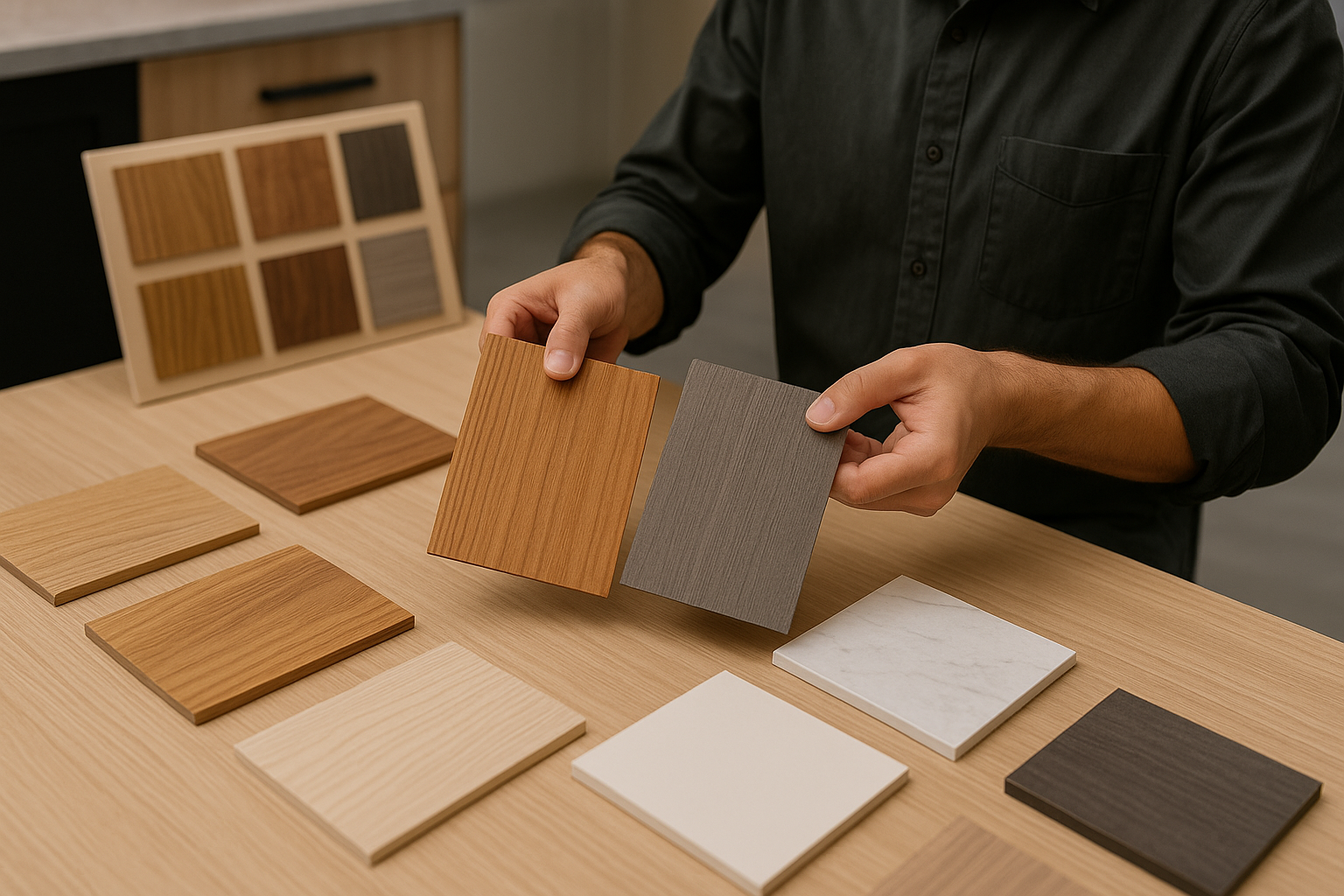What Is Timber Veneer?
Timber veneer is a thin slice of real wood, typically between 0.3mm and 2.5mm thick, bonded to a core substrate such as MDF, particleboard, or plywood. Because it’s made from actual timber, each veneer panel is unique, showcasing the natural grain and texture of the tree it came from.
Key characteristics:
- Real wood grain and tone
- Natural imperfections and character
- Available in a wide range of species, cuts, and finishes
What Is Laminate?
Laminate is a manufactured surface, made by pressing together layers of paper and resin under high pressure and temperature. Its top layer is a printed design, often made to mimic timber, stone, or concrete, sealed with a protective coating.
Key characteristics:
- Consistent and uniform appearance
- Highly durable and moisture resistant
- Easy to clean and cost-effective
Timber Veneer vs Laminate: How They Compare
Appearance & Aesthetics
- Timber Veneer:
Offers natural variation in grain and tone. Each panel is unique, giving warmth, richness, and a high-end feel. Perfect for design-led interiors that emphasise authenticity and materiality. - Laminate:
Uniform and consistent. Great for large-scale applications requiring visual continuity across many panels or surfaces.
Verdict: Choose timber veneer for organic, statement-making spaces. Choose laminate for consistency across volume installs.
Durability & Maintenance
- Laminate:
Highly resistant to scratches, water, stains, and UV damage. Ideal for high-traffic areas like kitchens, bathrooms, or retail environments. Requires minimal upkeep. - Timber Veneer:
More delicate and susceptible to scratching or moisture unless properly sealed. However, minor damage can often be sanded and refinished, unlike laminate, which cannot be repaired once worn.
Verdict: Laminate wins for low-maintenance, high-use environments. Veneer offers repairability.
Cost & Budgeting
- Laminate:
Lower upfront cost. Ideal for budget-conscious builds or volume-based projects. - Timber Veneer:
More expensive than laminate, but much more affordable than solid timber. Offers a luxury finish without the full timber price tag.
Verdict: Laminate is the cost-effective choice for practical applications. Veneer is an investment in premium aesthetics.
Environmental Impact
- Timber Veneer:
A more sustainable choice when sourced responsibly. Because it uses thin slices of timber, it maximises yield from a single log. FSC® and PEFC-certified options are widely available. - Laminate:
Made with synthetic resins and plastics, often petroleum-based. Non-biodegradable and higher in embodied carbon.
Verdict: For sustainable design, timber veneer is the better option, especially when certified.
Fire Safety & Health
- Laminate:
While durable, laminate can emit toxic fumes when burned due to its synthetic resin content. - Timber Veneer:
A natural material that does not release harmful chemicals during combustion. Fire-rated versions are available in both materials to meet building codes.
Verdict: From a health and wellness perspective, veneer is a safer and greener option when fire ratings are equal.
So, Which One Should You Choose?
Choose Timber Veneer if you want:
- A natural, high-end look
- Unique patterns and character
- A material that ages beautifully
- Sustainable credentials for green building projects
- Customisation in species, grain, and finish
Choose Laminate if you want:
- A cost-effective material
- Low-maintenance and high durability
- Uniformity across large spaces
- Water- and scratch-resistance for functional areas
- A practical option for rentals or fast-paced environments
Find the Right Fit for Your Project
Ultimately, the choice between timber veneer and laminate comes down to purpose, priorities, and budget. If your project is design-focused, where texture, tone, and timeless appeal matter, timber veneer offers a natural advantage. If durability, affordability, and efficiency are key, laminate gets the job done.
Looking for a solution that blends the warmth of real wood with practical performance? You may even choose to combine both materials strategically across your project, veneer for feature zones, and laminate for utility surfaces.
Explore our extensive range of timber veneers and surface materials at Bord Products, or contact our team for tailored advice based on your project needs. For more expert insights, check out our resources page.

Explore Bord Products
Our Melbourne facility produces hundreds of veneer and laminate panels daily, giving us total control over timeframes and quality.

Visit Our Showroom
Get expert advice on material selection for your project and see our entire range of veneers and laminates in person.

Specify Sustainable
We support sustainable forest management in Australia and across the globe. Look out for certified products on our website or speak to us.




